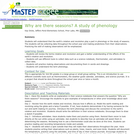
Read the Fine Print
Learners will compare images of planets and select one planet to visit and tell the tale of their visit through a comic strip. This is activity 9 of 9 in Mars and Earth: Science Learning Activities for After School.
- Subject:
- Physical Science
- Space Science
- Material Type:
- Activity/Lab
- Lesson Plan
- Date Added:
- 11/05/2014
